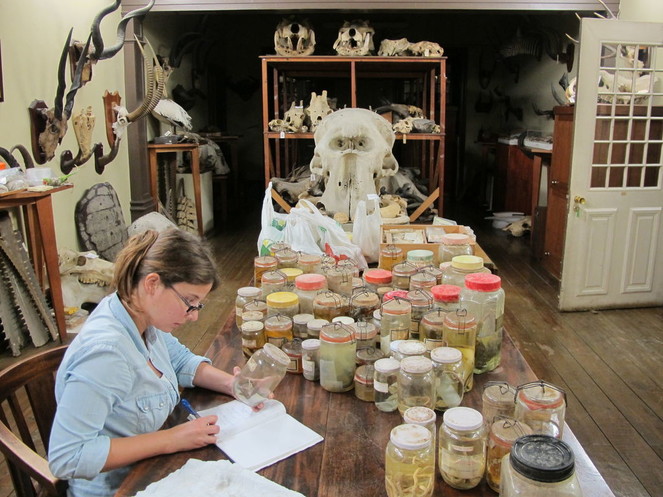|
Biodiversity Information Science and Standards : Conference Abstract
|
|
Corresponding author: Luis Miguel Pires Ceríaco (luisceriaco@gmail.com)
Received: 13 Jun 2019 | Published: 19 Jun 2019
© 2019 Luis Miguel Pires Ceríaco, Mariana Pimentel Marques
This is an open access article distributed under the terms of the Creative Commons Attribution License (CC BY 4.0), which permits unrestricted use, distribution, and reproduction in any medium, provided the original author and source are credited.
Citation: Pires Ceríaco L, Pimentel Marques M (2019) New Uses for an Old and Abandoned Colonial Collection: The herpetological collection of the Instituto de Investigação Científica Tropical (Lisbon, Portugal). Biodiversity Information Science and Standards 3: e37268. https://doi.org/10.3897/biss.3.37268
|
|
Abstract
The herpetological collections of the Instituto de Investigação Científica Tropical (Lisbon, Portugal) are the largest and most diverse collections of amphibians and reptiles in the country. These were collected in the mid-twentieth century in the former Portuguese colonies in Africa and Asia, and were the object of study of several naturalists that used them to describe and catalogue the herpetofauna of those areas. After the independence of these colonies in the mid 1970's, the research on this material nearly halted, and the collections became abandoned, without proper curation and lacking accessibility. In 2015, we started a process to recover these collections (Fig.
Initial phase of the recovery process of the herpetological collections of the Instituto de Investigação Científica Tropical (Lisbon, Portugal). Photo by Luis M. P. Ceríaco
Currently, the collection is completely accessible, both physically and electronically, and it is being used by researchers and students around the world. Some results have already been published including the description of species new to science (
This presentation provides an overview of the recovery process of the collection, discusses strategies on how to digitize and make historical collections available to the community, and demonstrates how biological collections amassed during colonial times can be of extreme importance to the study and preservation of present day biodiversity.
Keywords
Africa, Asia, digitization, georeference, amphibians, reptiles
Presenting author
Luis Miguel Pires Ceríaco
Presented at
Biodiversity_Next 2019
Hosting institution
Museu de História Natural e da Ciência da Universidade do Porto (Porto, Portugal);
Museu Nacional de História Natural e da Ciência, Universidade de Lisboa (Lisbon, Portugal);
Instituto de Investigação Científica Tropical, Universidade de Lisboa (Lisbon, Portugal)
References
-
Lost in the middle of the sea, found in the back of the shelf: A new giant species of Trachylepis (Squamata: Scincidae) from Tinhosa Grande islet, Gulf of Guinea.Zootaxa3973(3):511‑527. https://doi.org/10.11646/zootaxa.3973.3.6
-
A review of the genus Trachylepis (Sauria: Scincidae) from the Gulf of Guinea, with descriptions of two new species in the Trachylepis maculilabris (Gray, 1845) species complex.Zootaxa4109(3):284‑314. [InEnglish]. https://doi.org/10.11646/zootaxa.4109.3.2
-
The “Cobra-preta” of São Tomé Island, Gulf of Guinea, is a new species of Naja Laurenti, 1768 (Squamata: Elapidae).Zootaxa4324(1):121‑141. https://doi.org/10.11646/zootaxa.4324.1.7
-
Diversity and distribution of the amphibians and terrestrial reptiles of Angola – Atlas of historical and bibliographic records (1840–2017).Proceedings of the California Academy of Sciences65(Supplement 2):1‑501. URL: http://researcharchive.calacademy.org/research/izg/PCAS%20v65%20Suppl%20II%2028Dept18%20Angola%20(CAS%20web).pdf
-
Review of the leaf-litter skinks (Scincidae: Panaspis) from the Gulf of Guinea Oceanic Islands, with the description of a new species.African Journal of Herpetology67(2):132‑159. https://doi.org/10.1080/21564574.2017.1413015
